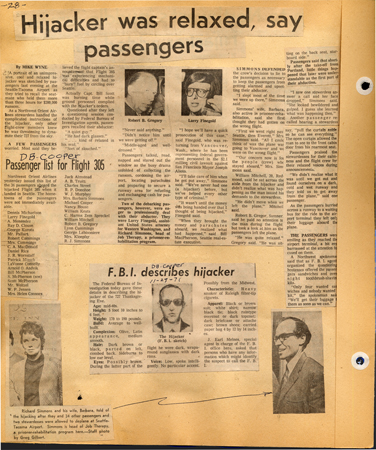Treasures of the Archives: Seattle, Port of, Ray Bishop Sea-Tac Scrapbook, 1942-1976

A new acquisition to the Washington State Digital Archives is the Ray Bishop Sea-Tac Scrapbook Collection. The scrapbook, created by an engineer who worked on the Sea-Tac project in the 1960 and 70s, contains photographs, newspaper clippings, project plans, and more, including a fascinating series of articles about one of Washington’s most infamous criminals.
On November 24, 1971, an ordinary-looking man in a black suit bought a $20 one-way ticket from Portland International to Sea-Tac airport. After the plane had taken off, the man who had called himself “Dan Cooper” slipped a note into the pocket of flight attendant Florence Schaffner. “I have a bomb in my briefcase,” the note read, “I will use it if necessary…You are being hijacked." Cooper calmly demanded $200,000 in unmarked bills and four parachutes upon landing at Sea-Tac airport. With his demands met, he released all the passengers, and instructed the crew to take off toward Mexico at low speed and altitude. While the plane was still over Washington State, Cooper asked the crew to head up to the cockpit. He then lowered the aft ramp and jumped into the darkness.
Despite a massive manhunt for the hijacker across Southwest Washington, no trace of Cooper was found. In 1978, a deer hunter in the area found a placard containing information on how to lower the back stairs of a 727 airliner. Two years later, an eight year old boy on vacation on the Columbia River found three packets of rotting $20 bills that FBI researchers confirmed to have been part of the ransom, but it was another dead end. The FBI maintains that Cooper likely did not survive his jump into the frigid rainstorm. Since 1971 there have been hundreds of theories and even a few death-bed confessions, but the case remains open.
The Cooper incident quickly entered legend as the most daring act of air piracy on record. There were fifteen copycat attempts at similar hijackings in 1972 alone, all failing spectacularly (as well as ushering in the era of airport security). The story, forever dubbed due to a journalistic mistake as the “D.B. Cooper hijacking” is just one of the interesting tales found in the Ray Bishop Sea-Tac Scrapbook Collection. The collection is a unique look at the early years of Sea-Tac Airport by one of the engineers who built it. Browse through the collection to see more interesting tidbits about Washington’s most important airport.

